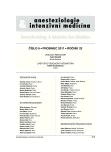Principles of mechanical ventilation in chronic obstructive pulmonary disease
Authors:
Beroušek Jan; Cvachovec Karel
Authors‘ workplace:
Klinika anesteziologie a resuscitace, Univerzita Karlova v Praze, 2. LF a IPVZ, Fakultní nemocnice Motol, Praha
Published in:
Anest. intenziv. Med., 22, 2011, č. 6, s. 343-347
Category:
Intensive Care Medicine - Review Article
Overview
Chronic obstructive pulmonary disease (COPD) has become the fourth most frequent cause of death in the European Union and in 2020 it may reach the third place. The treatment cost amounts to € 38.6 billion a year. In the cases when conservative and oxygen therapy do not achieve a sufficient effect and progressive respiratory failure appears, it is necessary to decide about the respiratory support and its form in a timely manner. The mechanical ventilation strategy can be divided into non-invasive and invasive. Non-invasive ventilation is recommended as the first choice in acute exacerbation of COPD. The weaning of a patient from the ventilator can be a very difficult and long-term process. The best method, however, has been a theme of discussions for a long time. This article offers a selection from a large number of publications, experiences and therapeutic options specialised in the ventilatory strategy when treating COPD that has progressed into respiratory failure.
Keywords:
chronic obstructive pulmonary disease – non-invasive ventilation – invasive mechanical ventilation – weaning from a ventilator – spontaneous breathing activity test – tracheostomy
Sources
1. Musil, J., Kos, S., Vondra, J., Salajka, F. Světová strategie diagnostiky, léčby a prevence CHOPN. 1. vyd. Praha : Vltavín, 2007, 164 p. ISBN 80-86587-22-3.
2. Roisin, R. R. et al. Global strategy for diagnosis, management and prevention of chronic obstructive pulmonary disease. Global Iniciative for Chronic Obstruktive Lung Disease, p. 2–63. [online]. 2010 [cit. 2011-05-05]. Dostupné na www: <http://www.goldcopd.org>.
3. Agusti, A. G. Systemic effects of chronic obstructive pulmonary disease. Proceedings of the American Thoracic Society, 2005, 2, p. 367–370.
4. Lange, P., Nyboe, J., Appleyard, M., Jensen, G., Schnohr, P. Ventilatory function and chronic mucus hypersecretion as predictors of death from lung cancer. American Review of Respiratory Disease, 1990, 141, p. 613–617.
5. American Thoracic Society and European Respiratory Society Standard for Diagnosis and Management of Pacients with COPD, p. 79–89, 120–150. [online]. 2004 [cit. 2011--05-05]. Dostupný na www: <http//www.thoracig.org>.
6. Conti, G., Antonelli, M., Navalesi, P., Rocco, M., Bufi, M., Spadetta, G., Meduri, G.U. Noninvasive vs. Conventional mechanical ventilation in pacients with chronic obstructive pulmonary disease after failure of medical treatment in the ward: a randomized trial. Intensive Care Med., 2002, 28, p. 1701–1707.
7. Antonelli, M., Bello, G. Noninvasive mechanical ventilation during the weaning process: facilitative, curative, or preventive. Critical Care Medicine, 2008, 12, p. 136.
8. Brochard, L. et al. Mechanical ventilation: invasive versus noninvasive. Eur. Respiratory Journal, 2003, 22, p. 31–37.
9. Lightowler, J. V., Wedzicha, J. A., Elliot, M. W. et al. Non-invasive positive pressure ventilation to treat respiratory failure resulting from exacerbations of chronic obstructive pulmonary disease, Cochrane systematic review and meta-analysis. British Medical Journal, 2003, 326, p. 185–189.
10. Dostál, P. a kol. Základy umělé plicní ventilace. 2. vyd. Praha: Maxdorf - Jessenius, 2005, 64 p., 181–184 p., 228–233 p., ISBN 80-7345-059-3.
11. Černý, V., Matějovič, M., Dostál, P. Vybrané doporučené postupy v intenzivní medicíně. Praha: Maxdorf-Jessenius, 2009, 70 p., 119–120 p. ISBN 978-80-7345-183-7.
12. Ferrer, M. et al. Noninvasive ventilation during persistent weaning silure. American Journal of Respiratory and Critical Care Medicine, 2003, 168, p. 70–76.
13. Brochard, L., Isabey, D., Piquet, J. et al. Reversal of acute exacerbations of chronic obstructive lung disease by inspiratory assistance with a face mask. New England Journal of Medicine, 1990, 323, p. 1523–1530.
14. Herold, I. Neinvazivní ventilace v intenzivní péči, současné indikace, doporučení a možnosti použití. [online]. 2008-01-03. [cit. 2011-06-10]. Dostupný na www:
<http://www.csarim. cz/RSystem/Soubory/NIVS Herold.pdf>.
15. Hill, N. S., Levy, M. M. Ventilator management strategies for critical care. New York: Marcel Dekker, 2001, p. 111–135. ISBN 082470522X.
16. Gunen, H., Hacievliyagil, S. S., Kosar, F., Mutlu, L. C., Gulbas, G., Pehlivan, E., Sahin, I., Kirkin, O. Factors affecting survival of hospitalised pacients with COPD, European Respiratory Journal, 2005, 26, p. 234–241.
17. Brochard, L., Rauss, A., Benito, S., Conti, G., Mancebo, J., Rekik, N. et al. Comparison of three methods of gradual withdrawal from ventilatory support during weaning from mechanical ventilation. American Journal of Respiratory and Critical Care Medicine, 1994, 150, 4, p. 896–903.
18. Pařízková, R. Odpojování od ventilátoru. [online]. 2007-12 - -13. [cit 2011-06-10]. Dostupný na www: <http://www.csarim. cz/ Public/csarim/doc/Odpojování-od-UPV-IPVZ-2007.pdf>.
19. MacIntyre, N. R., Cook, D. J., Ely, E. W., Epstein, S. K., Fink, J. B., Heffner, J. E. et al. Evidence-based guidelines for weaning and discontinuing ventilatory support: a collective task force facilitated by the American College of Chest Physicians; the American Association for Respiratory Care; and the American College of Critical Care Medicine. Chest, 2001, 120, Suppl. 6, p. 375–395.
20. Griffiths J. et al. Systematic review and meta – analysis of studies of the timing of tracheostomy in adult patients undergoing artificial ventilation. British Medical Journal, 2005, 330, p. 1243–1247.
21. Purro, A., Appendini, L., De Gaetano, A., Gudjonsdottir, M., Donner, C. F., Rossi, A. Physiologic determinants of ventilator dependence in long-term mechanically ventilated patients. American Journal of Respiratory and Critical Care Medicine, 2000, 161, p. 1115–1123.
Labels
Anaesthesiology, Resuscitation and Inten Intensive Care MedicineArticle was published in
Anaesthesiology and Intensive Care Medicine

2011 Issue 6
Most read in this issue
- Principles of mechanical ventilation in chronic obstructive pulmonary disease
- Severe course of Still’s disease with multiple organ failure with predominant liver failure
- The fascial plane concept
- To cool or not to cool? Obstacles to implementing therapeutic hypothermia guidelines
